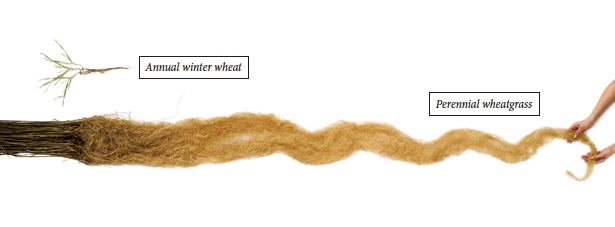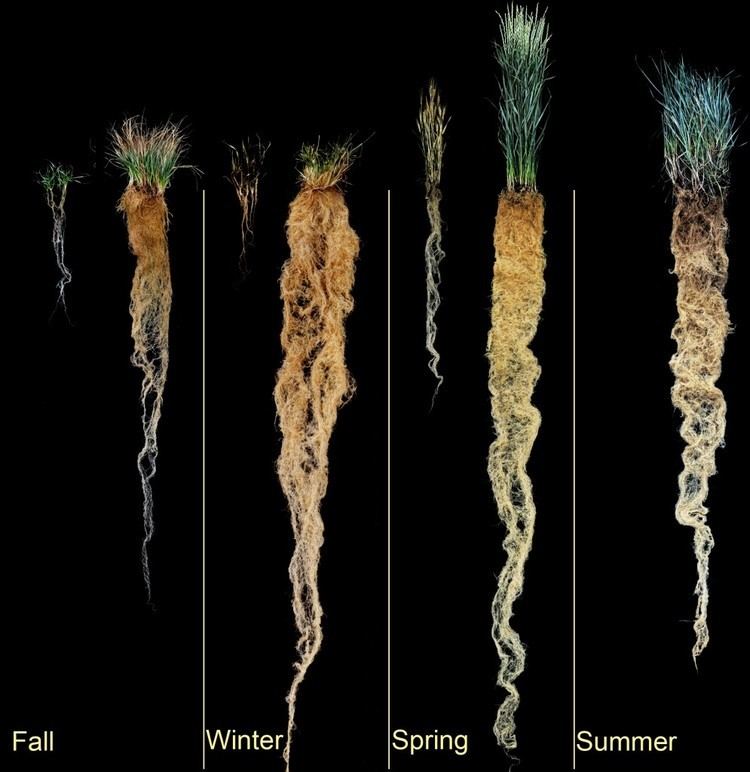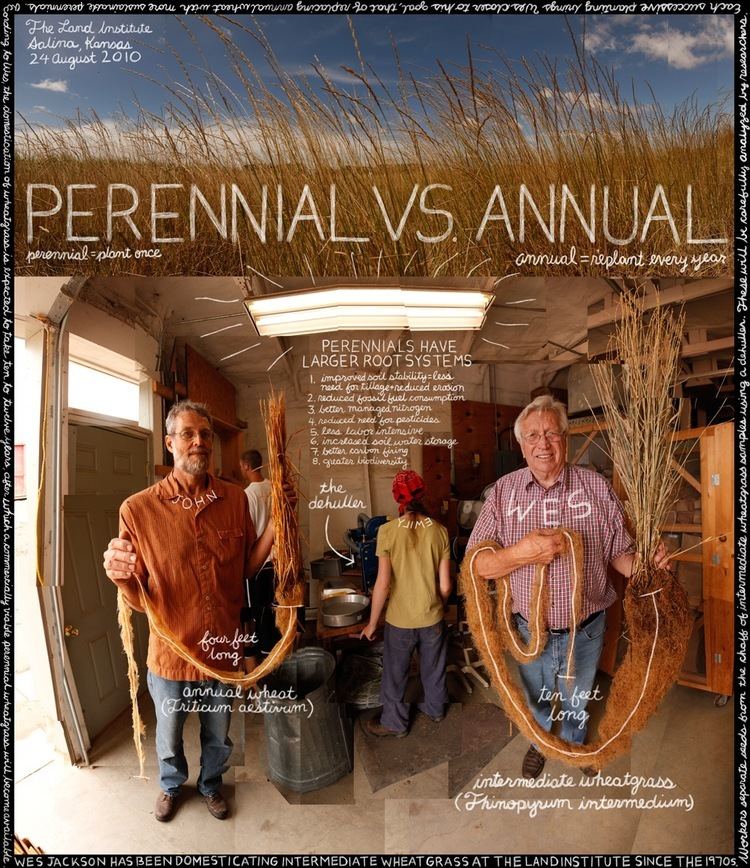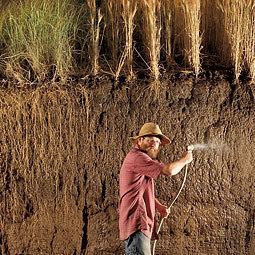 | ||
Similar Winter wheat, Oryzopsis hymenoides, Upland rice, Wheatgrass, Glutenin | ||
Sepp holzer s perennial grain at paul wheaton s laboratory farm
A perennial grain is a grain crop that lives and remains productive for two or more years. While many fruit, nut and forage crops are long-lived perennial plants, all major grain crops presently used in large-scale agriculture are annuals or short-lived perennials grown as annuals. Scientists from several nations have argued that perennial versions of today's grain crops could be developed and that these perennial grains could make grain agriculture more sustainable.
Contents
- Sepp holzer s perennial grain at paul wheaton s laboratory farm
- Perennial grains climate smart by design dr lee dehaan
- Rationale
- Methods for developing perennial grains
- Potential disadvantages of perennial crops
- Advantages of perennial crops
- References

Perennial grains climate smart by design dr lee dehaan
Rationale

The 2005 Synthesis Report of the United Nations’ Millennium Ecosystem Assessment program labeled agriculture the “largest threat to biodiversity and ecosystem function of any single human activity.” Perennial grains could reduce this threat, according to the following logic:

Methods for developing perennial grains
Three ways of developing perennial grain crops have been proposed:

- The primary gene pools of several domesticated grain crops include perennial types, even though these crops are generally grown as annuals. Pigeon pea is a large-seeded grain legume (pulse) with both short-season (annual) and long-season (perennial) varieties. If the highest-yielding annual varieties were hybridized with the longest-living varieties, robustly perennial, high-yielding varieties could be developed.
- The secondary or tertiary gene pools of most domesticated grain crops include perennial species. Gene exchange between such species is possible, though sometimes difficult. Genes enhancing the agronomic traits of wild perennials, increased seed size, for example, could be brought in from domestic grain relatives. Alternately, genes increasing the lifespan of domesticated grains could be obtained by crossing with wild perennial relatives. For example, domestic Asian rice can be crossed with wild perennial rice species to exchange genes for many traits.
- Wild perennial plants with oil-, carbohydrate- or protein-rich seeds could be domesticated without any wide hybridization. Although our grain crops were all domesticated thousands of years ago, modern genetic theory and molecular genetic techniques may greatly accelerate the process compared with the original process of domestication. The Rodale Institute and The Land Institute have each had plant breeding projects in which a wild, perennial grass, Thinopyrum intermedium was subjected to recurrent cycles of selection for improved grain traits.
Potential disadvantages of perennial crops
- Does not address food security today. Perennial grain crops are in the early stages of development and may take many years before achieving yields equivalent to annual grains.
- Makes crop rotation more difficult. Crop rotations with perennial systems are possible, but the full rotation will necessarily take longer. For example, a perennial hay crop. like alfalfa is commonly rotated with annual crops or other perennial hay crops after 3–5 years. The slower pace of rotation—compared with annual crops—could allow a greater buildup of pathogens, pests or weeds in the perennial phase of the rotation.
- Builds soil organic matter at the expense of plant productivity. In the absence of tillage, and in soils with depleted organic matter, crops with large root systems may build up organic matter to the point that nearly all of the soil nitrogen and phosphorus is immobilized. When this happens, productivity may decline until either the organic matter builds up to a level where equilibrium is reached between nutrient mineralization and nutrient immobilization or fertilizer is added to the system.
- Hydrological impacts. Perennial plants may intercept and utilize more of the incoming rainfall. than annual plants each year. This may result in water tables dropping and/or reduced surface flow to rivers.
- Reduced nutrient delivery to downstream farms. Wide replacement of annual with perennial plants on agricultural landscapes could stabilize soils and reduce nitrate leaching to the point that the delivery of sediment and dissolved nitrogen to downstream landscapes could be reduced. Farmers in these areas may currently rely on these nutrient inputs. On the other hand, other sectors might benefit from improved water quality.
- Improved habitat for pests. If fields are not left bare for a portion of the year, rodents and insects populations may increase. Burning of the stubble of perennial grains could reduce these populations, but burning may not be permitted in some areas. Furthermore, rodents and insects living underground would survive burning, whereas tillage disrupts their habitat.
Advantages of perennial crops
Several claims have been published:

- Greater access to resources through a longer season.Perennial plants typically emerge earlier than annuals in the spring and go dormant in the autumn well after annual plants have died. The longer growing season allows greater interception of sunlight and rainfall. For example, In Minnesota, annual soybean seedlings emerge from the soil in early June. By this time perennial alfalfa has grown so much that it is ready for the first harvest. Therefore, by the time a soybean crop has just begun to photosynthesize, a field of alfalfa has already produced about 40% of the season’s production.
- Greater access to resources through a deeper rooting zone. Most long—lived plants construct larger, deeper root systems than short-lived plants adapted to the same region . Deeper roots enable perennials to "mine" a larger volume of soil each year. A larger volume of soil also available for exploitation per unit of cropland also means a larger volume of soil water serves as a reservoir for periods without rainfall.
- More efficient use of soil nutrients. Leaching of nitrogen from fertilizer has been found to be much lower under perennial crops such as alfalfa (lucerne) than annual crops such as maize. A similar phenomenon is seen in unfertilized fields harvested for wild hay. While adjacent wheat fields required annual inputs of fertilizer, the wild perennial grasses continued to produce nitrogen-rich hay for 75 to 100 years with no appreciable decline in productivity or soil fertility. Presumably, the larger root systems of the perennial plants and the microbial community they support intercept and cycle nutrients passing through the system much more efficiently than do the ephemeral root systems of crop plants.
- Sustainable production on marginal lands. Cassman et al. (2003) wrote that for large areas in poor regions of the world, “annual cereal cropping …is not likely to be sustainable over the longer term because of severe erosion risk. Perennial crops and agroforestry systems are better suited to these environments.” Current perennial crops and agroforestry systems do not produce grain. Grain provides greater food security than forage or fruit because it can be eaten directly by humans (unlike forage) and it can be stored (unlike fruit) for consumption during the winter or dry season.
- Reduced Soil erosion U.S. Forest Service et al. cite perennial grasses as a preventative for soil erosion. Perennials of all kinds establish thick root systems which tie up soil and prevent surface erosion by wind and water. Since water runoff is slowed, it has a longer time to soak in and enter the groundwater system. Net water inflow into streams is marginally reduced due to groundwater infusion, but this also reduces high flow rates in streams associated with fast-flowing water-based erosion of streambeds. .
- Increased wildlife populations U.S. Forest Service et all cite slower release of water into streams, which makes water levels more consistent instead of alternating between dry and flash-flood situations common to deserts. Consistent water levels contribute to increased wildlife populations of fish, amphibians, waterfowl, and mammals dependent upon a consistent water source.
